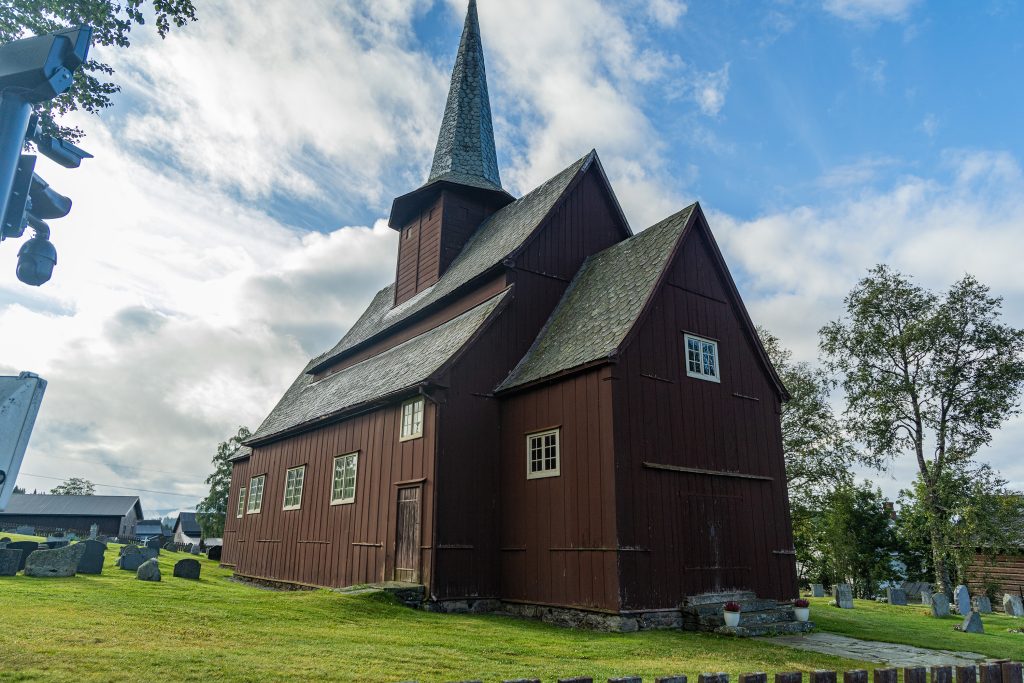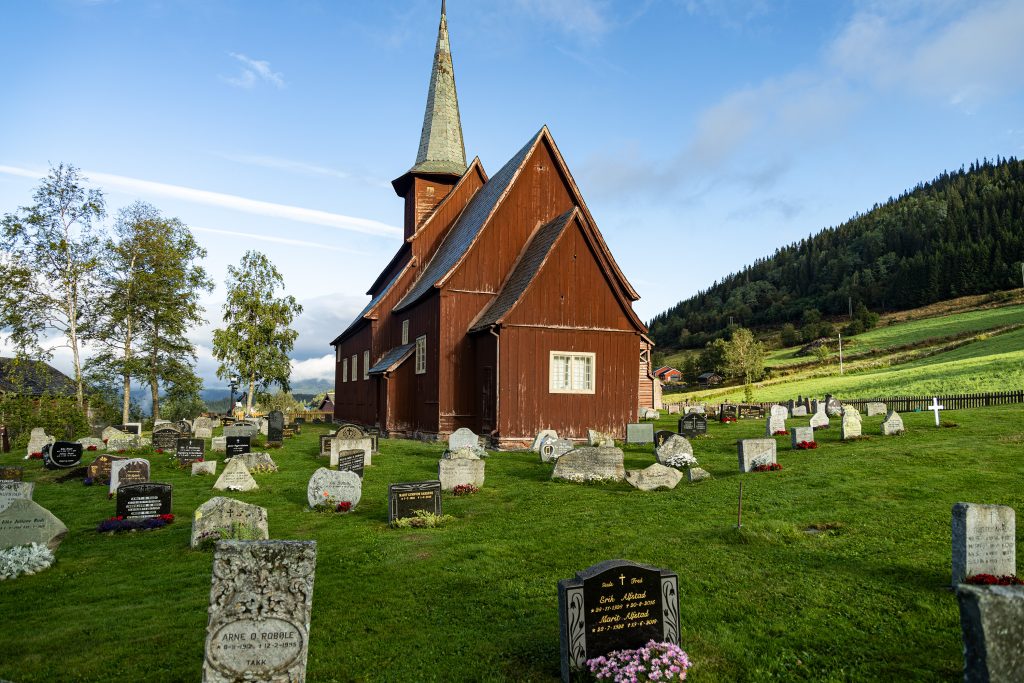
Hegge Stavkirke
Drewniany kościółek Hegge można znaleźć w gminie Øystre Slidre w okręgu Innlandet, we wsi Hegge. Przemierzając drogę 51 (trasę krajobrazową prowadzącą w góry Jotunheimen) warto zrobić króki objazd kilka kilometrów na południe od Beitostølen, aby zobaczyć ten obiekt architektoniczny z XIII wieku. Jego powstanie datowane jest na rok 1216 i wciąż jest używany jako kościół parafialny (może pomieścić 150 osób).
Budowla oparta jest na ośmiu stojących wewnętrznych kolumnach, tworzących arkadę, otaczającą centalny obszar z podniesionym dachem. Świątynia jest długa, z prostokątną nawą i mniejszym, węższym chórem. Kolumny, na których opiera się konstrukcja ozdobione są rzeźbionymi motywami, spotykanymi również w innych średniowiecznych kościołach. Na jednej z kolumn znajduje się napis runiczny, który można przetłumaczyć jako “Erling Arnson napisał te runy”. Może być to ten sam Erling, którego imię odkryto wyryte w innej świątyni niedaleko, w Høre.
Dawniej wokół kościoła przebiegała zadaszona galeria, która również jest czynnikiem wspólnym dla kilku zachowanych do naszych czasów kościołów klepkowych.
Hegge stavkirke nie przyypomina wyglądem tych najbardziej znanych kościółków jak te z Borgund czy Heddal. To efekt licznych przebudów i renowacji. Obecny kościółek został zlożony z dwoch innych świątyń z rejonu Valdres, które mogły być już nieużywane. Prace renowacyjne miały miejsce w latach 1694, 1706, 1712. Zachodnia dobudówka powstała w 1842 roku. Dwa lata później kościół powiększono, poszerzając chór. W 1864 roku dobudowano zakrystię, a płaski sufit przykryto odwróconą łodzią, upodobniając w ten sposób wnętrze do innch średniowiecznych budowli tego typu. W 1872 kościół pomalowano na biało. Obecna czerwono – brązowa elewacja to efekt późniejszych zabiegów konserwujących.
Z ostatnim większym remontem w 1923 – 1924 dodano bądź wymieniono kamienne fundamenty, które zapewniają większą stabilność konstrukcji oraz dobudowano nowe schody do galerii i wieży.
Wnętrze kościoła zdobią wspomniane rzeźby na kolunach, przedstawiające twarze, prawdopodobnie królów (jedna z nich może jednak przedstawiać samego Odyna, ale ta wersja nie jest w żaden sposób potwierdzona). Drugim oryginalnym elementem wyposażenia jest chrzcielnica wykonana z kamienia, datowana na XI wiek. Wokół niej znajdją się dekoracje przedstawiajace drzewa, ludzkie postacie i gwiazdy. Na wyposażeniu świątyni znaleźć także można szatę liturgiczną z 1686 roku i obraz “Ofiary Izaaka” z 1643 roku.
Ołtarz pochodzi z 1782 roku i jak głosi legenda został ufundowany przez czterech rolników, których potężna burza zastała w sąsiedniej dolinie, gdzie zamierzali sprzedać bydło. Poprzysięgli, że jeśli przeżyją, każdy z nich zaofiaruje kościołowi sumę równoważną wartości krowy. Jak można się domyślać, cała czwórka przeżyła i ufundowała ołtarz. Na ołtarzu znajdują się dwie pary charakterystycznych świeczników z około 1600 roku, kielich z 1685 roku i trzy stare biblie, wydrukowane w 1699, 1738 i 1764 roku.
Ostatnim elementem wartym uwagi jest rzeźbiona brama pochodząca ze średniowiecza, prowadząca na dziedziniec kościoła i cmentarz.
The Hegge Stave Church can be found in the Øystre Slidre municipality in Innlandet county, in the village of Hegge. When travelling along road 51 (a scenic route leading to the Jotunheimen mountains), it is worth taking a short detour a few kilometres south of Beitostølen to see this 13th century architectural structure. It dates back to 1216 and is still used as a parish church (it can accommodate 150 people).
The building is based on eight standing inner columns, forming an arcade, surrounding a central area with a raised roof. The church is long, with a rectangular nave and a smaller, narrower choir. The columns on which the structure rests are decorated with carved motifs, also found in other medieval churches. On one of the columns is a runic inscription, which can be translated as “Erling Arnson wrote these runes”. This may be the same Erling whose name was discovered engraved in another church nearby, in Høre.
In the past, a covered gallery ran around the church, which is also a common factor for several remaining stave churches.
Hegge stavkirke does not resemble the most famous stave churches such as those in Borgund or Heddal. This is the result of numerous reconstructions and renovations. The present church was composed of two other churches from the Valdres area, which may have already been unused. Renovations took place in 1694, 1706, 1712. The western extension was built in 1842. Two years later, the church was enlarged, widening the choir. In 1864, a sacristy was added, and the flat ceiling was covered with an inverted boat, thus making the interior similar to other medieval buildings of this type. In 1872, the church was painted white. The current red-brown elevation is the result of later conservation treatments.
With the last major renovation in 1923-1924, stone foundations were added or replaced, which provide greater stability to the structure, and new stairs were built to the gallery and tower.
The interior of the church is decorated with the aforementioned sculptures on the columns, depicting faces, probably of kings (one of them may, however, depict Odin himself, but this version is not confirmed in any way). The second original element of the equipment is the baptismal font made of stone, dated to the 11th century. Around it, there are decorations depicting trees, human figures and stars. The church’s equipment also includes a liturgical vestment from 1686 and a painting of the „Sacrifice of Isaac” from 1643.
The altar dates back to 1782 and, as legend has it, was funded by four farmers who were caught in a powerful storm in a neighboring valley, where they intended to sell cattle. They vowed that if they survived, each of them would donate a sum equivalent to the value of a cow to the church. As you might guess, all four survived and funded the altar. The altar contains two pairs of characteristic candlesticks from around 1600, a chalice from 1685 and three old bibles, printed in 1699, 1738 and 1764.
The last element worthy of note is the carved medieval gateway leading to the church courtyard and cemetery.














